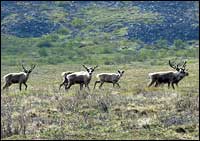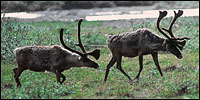



|
Arctic National Wildlife Refuge Caribou If you would like to see the caribou in Arctic National Wildlife Refuge Backcountry Safaris offers guided trips to the refuge. Topics on this page: Porcupine Caribou Herd
Sometime in April, the caribou head north toward the traditional calving grounds on the arctic coastal plain, 400 miles away. The route they take depends on snow and weather conditions. By early June, the pregnant females reach the calving areas and give birth. Shortly thereafter, most, and often all, of the herd joins the cows and calves to forage on the coastal plain of the Refuge. In late June and early July, when hordes of mosquitos hatch, the caribou gather in huge groups numbering in the tens of thousands. Seeking relief from the insects, they move along the coast, onto ice fields, and to uplands in the Brooks Range. The herd leaves the coastal plain by mid-July, heading back east and south toward its fall and wintering areas. Just as no one knows in advance precisely where most of the caribou will drop their calves in the spring, no one knows until it happens whether the majority of the herd will winter on the south side of the Refuge or in Canada. Wandering across remote areas, individual caribou may travel more than 3000 miles during their yearly movements. Hunted by local residents, chased by predators, harassed by insects, challenged by river crossings, and faced with difficult terrain and weather, the Porcupine herd confronts many hardships. Yet it thrives, every summer staging a magnificent wildlife spectacle on the arctic coastal plain. The caribou are a vital part of the natural system that operates there. Unalterably linked to the area, the herd both depends on and enhances the dynamic wilderness that is the Arctic Refuge. Central Arctic Caribou Herd
Soon after calving season, Central Arctic herd caribou move outward both east and west to their summer range, which extends from the 1002 Area of the Arctic Refuge well west beyond Prudhoe Bay. In the fall, many of these caribou migrate south through the Brooks Range mountains to spend the winter along south slope river drainages deep within the Arctic Refuge. Some members of the herd, however, remain on their summer range north of the mountains throughout the year, seeking out wind-blown valleys and tundra benches to find the lichens they need in order to survive the long, cold winters.
Caribou and the Coastal Plain The calving grounds of the Porcupine caribou herd include the northern foothills of the Brooks Range and the arctic coastal plain from the Tamayariak River in Alaska to the Babbage River in Canada. The most often used calving area, however, is on the Refuge coastal plain between the Katakturuk and Kongakut Rivers. Commonly, one-half to three quarters or more of the calves are born within this area.
The Refuge coastal plain is very important to calving success and calf survival in the Porcupine caribou herd. There are two main reasons for this. First, fewer brown bears, wolves, and golden eagles live on the coastal plain than in the adjacent foothills and mountains. As a result, the newborn calves have a better chance to survive their first week, until they become strong enough to outrun their pursuers. The Refuge coastal plain also provides an abundance of plant species preferred by caribou. Nutrition is very important to the pregnant and nursing cows, particularly after the long winter. The timing of snow melt and plant "green up" on the coastal plain coincides with their calving period. This gives the new mothers access to the most nutritious food when it is most important for their health and the proper development of nursing calves.
Their annual visit to the Refuge coastal plain brings new life and vitality to the caribou. It is an important part of their life cycle. The coastal plain provides the caribou vital nourishment and a better chance of avoiding predators and insects. This relationship is part of the unaltered system that makes the Arctic Refuge such a wondrous place. References and Additional Information Additional information about caribou is available on the web sites listed below.
More general information on ANWR is available at: Arctic National Wildlife Refuge We would like to thank the Arctic National Wildlife Refuge for the above information. |
|



 Named for the major river within its range, the Porcupine Caribou herd uses an area the size of Wyoming in the Refuge and the Yukon and Northwest Territories. The animals winter in the southern portion of their range, including the Refuge, where they are an important resource for the Gwich'in people.
Named for the major river within its range, the Porcupine Caribou herd uses an area the size of Wyoming in the Refuge and the Yukon and Northwest Territories. The animals winter in the southern portion of their range, including the Refuge, where they are an important resource for the Gwich'in people.
 Central Arctic herd animals that winter near Arctic Village, just beyond Arctic Refuge's southern boundary, are an important subsistence resource for the people living in that community. These villagers harvest caribou for food throughout the winter. The herd is also hunted on its coastal summer range by villagers traveling by boat from Kaktovik. The Central Arctic herd has increased in numbers over the past 10 years, ensuring hunters that caribou are available in adequate numbers to supply villagers with this sustaining bounty.
Central Arctic herd animals that winter near Arctic Village, just beyond Arctic Refuge's southern boundary, are an important subsistence resource for the people living in that community. These villagers harvest caribou for food throughout the winter. The herd is also hunted on its coastal summer range by villagers traveling by boat from Kaktovik. The Central Arctic herd has increased in numbers over the past 10 years, ensuring hunters that caribou are available in adequate numbers to supply villagers with this sustaining bounty.
 The entire Porcupine caribou herd and up to a third of the Central Arctic herd use the Refuge coastal plain when calving is completed. This essential area contains forage and a variety of habitats that provide insect relief, including the coast, uplands, ice fields, rocky slopes, and gravel bars.
The entire Porcupine caribou herd and up to a third of the Central Arctic herd use the Refuge coastal plain when calving is completed. This essential area contains forage and a variety of habitats that provide insect relief, including the coast, uplands, ice fields, rocky slopes, and gravel bars.